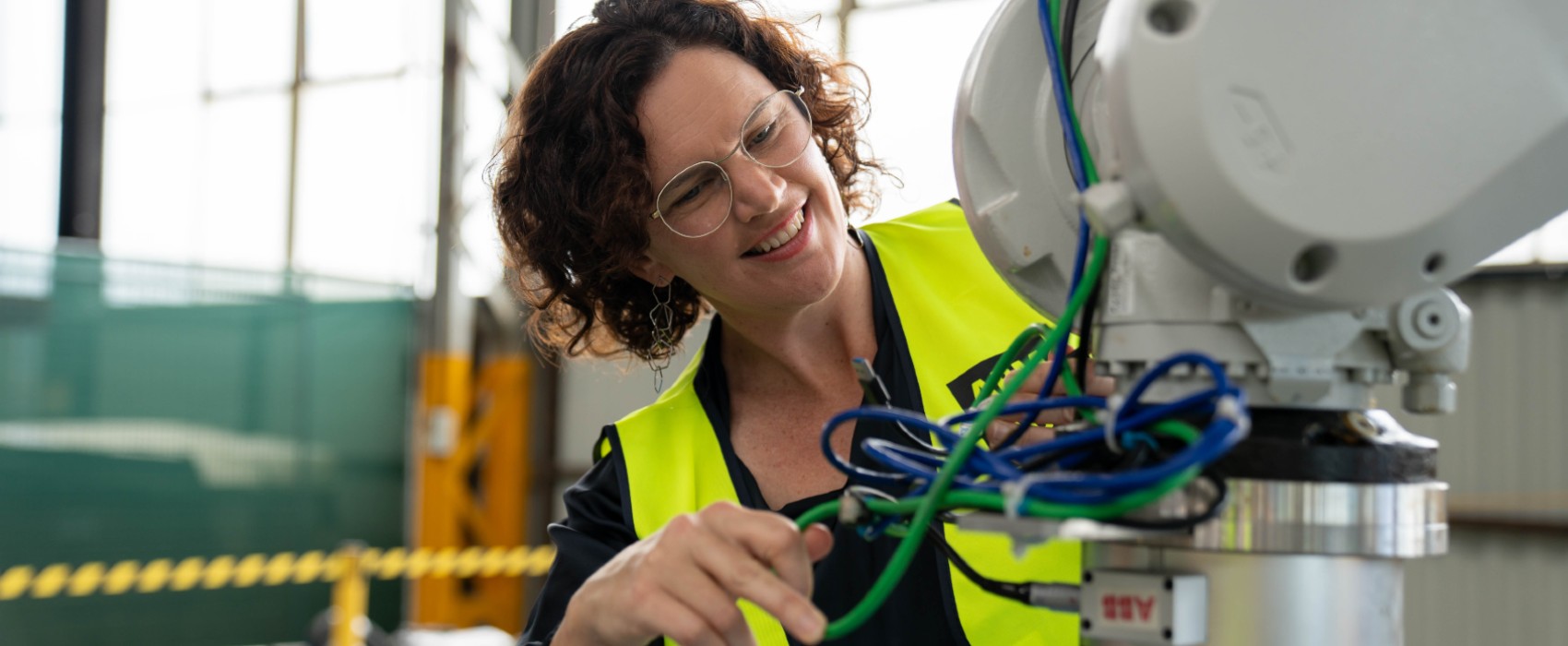“Every company is a technology company”, is a line often used as shorthand to describe how the digital age has changed business. It doesn’t matter if you build bridges or provide services – you're going to need to grapple with the impact of technology on what you do and how you do it.
It came to mind during our latest Future Led with Associate Professor Cori Stewart, who is the founder and CEO of the Advanced Robotics for Manufacturing (ARM) Hub.
Our Future Led series features experts discussing their field, sharing insights, and offering any predictions they might have. It’s an opportunity for our team to learn about the trends and challenges of the future (blockchain, energy security, cybersecurity, for example).
Cori joined us to chat about Australia’s manufacturing future, how robotics and AI can make a difference, and what it takes to make collaborations successful.
The ARM Hub is an industrial facility that specialises in robotics, artificial intelligence (AI), and technologies such as augmented and virtual reality (AR and VR) to support advanced manufacturing solutions and commercialisation opportunities.
Its goal is to accelerate the digital transformation of industry.
“Digital transformation of industry is when you have companies that realise, regardless of what they do, that they’re digital businesses,” Cori told us.
“ARM Hub is about supporting industry to be smart enough and competitive enough globally to do manufacturing here.”
Digital transformation is very much in our wheelhouse at Liquid, so it was fascinating to gain some insights into the sorts of challenges facing other domains.

ARM Hub's Cori Stewart speaking with Liquid's Katie Cassidy.
From manufacturing companies to data companies
There’s a lot to do and a lot of collaboration needed if there’s going to be an AI-led manufacturing revival in Australia, but Cori is optimistic. She believes we have the smarts and the skills, and she’s passionate about helping to make it happen.
Cori and her team collaborate mostly with small and medium-sized enterprises (SMEs), helping to solve technical problems or elevate digital capability.
“The engine room for manufacturing is SMEs,” she said.
“What we found, particularly with SMEs, was that until they could see it in action – this is the robot, this is how it works, this is what the person does, this is what’s hard, this is what’s digital and this is what’s hand-done – they really had lots of barriers to thinking about how to adopt that kind of technology.
“So part of what we do is give some independent advice. We don't sell hardware; we don't sell software. We're a service and we don't have preferred suppliers, so it allows us to be independent.”
The pandemic years have taught us that being able to make things in Australia is fundamental for our sovereign capability, but getting businesses to think digitally can still be a challenge.
“Most companies who come to us think of themselves as making something, they're not thinking about data, or how to use data or manage data,” Cori said.
“As soon as that switch flips, when they realise the potential possibilities and the risks of not thinking about themselves like a data company—regardless of what they make or do—I think that’s when they've, at least mentally, done the digital transformation. Once you're on the path, it's a continuum.”
Start with the problem
The first step of any digital transformation journey is the problem.
“We’re looking at solving things with people,” Cori said.
“Robots are fabulous, but robots aren't for everyone. Not everything's a robot problem. Great if it was, but it's just not.
“Companies absolutely need to be adopting technologies that are going to make them able to compete quickly. The most important thing is to start and as soon as they're on that journey, I think that their ability to take on technology, use it, and get the benefits, is quite rapid. They're often really surprised how quick that is, particularly around design to manufacture.”
Often, Cori added, the opportunity or challenge is understanding what it is that's going to take a company to the place they need to be.
“There is so much talent that could go into solving a project, there’s so many investment models that they might need to think about, or they could just simply be commercial collaboration partners. That’s what we try and do,” she said.
“Some technologies are really just about training and adoption, you don't have to build them. You don’t really even have to maintain some of them. You can just kind of use them and get really good at using them, which is exciting for the lowest entry point of getting benefit.
“That's why I think AR and VR is a good entry if you're doing that digital transformation, if you're looking at a company that's small and vulnerable and hasn't done it before.”

Cori and the ARM Hub team help with technical problems and digital capability. (Image courtesy ARM Hub)
Robots are ‘just another tool’
Manufacturing is about adding value to the things we create. That’s where robotics and AI, and other digital technologies, can help—not only in adding value to a product, but for jobs as well.
“Future jobs that are highly paid, that are using high-tech solutions, are actually manufacturing jobs. They might be the digital or data part of it, but they are manufacturing jobs,” Cori explained.
She also advocated for a positive view of robots as modern tools, rather than a technology to fear.
“We should really use all the modern tools that we can and we should use our human brain to do the things that it's best used for, which is the more difficult and dexterous things.
“Companies are worried, people are worried, especially if the company has workers that are across the spectrum of skilled in digital and not skilled in digital… so that's a real thing to manage.
“For a person who has been working in a company for 35 years – they know all the processes, they are the expert in the thing, they are the ones who know what good looks like.
“They're the ones that usually end up with the first robot in a system because they're probably the ones that are doing the backbreaking work, and we can get rid of a lot of that. It's getting rid of all that dirty, dull, dangerous stuff. That's the win for me.”
It’s a sentiment that was echoed recently by the Minister for Industry and Science, Ed Husic.
“Robotics technologies will be part of our industrial future... It’s not about replacing workers. It cannot be about replacing workers,” he said in a speech.
“We are not racing against robots, we are racing with them – to industries and jobs of the future. Manufacturers are already entwining automation with human skill, to develop secure, well-paying jobs.”
Collaboration is hard, but not impossible
So how do we get there? There are many challenges facing manufacturers and the nation, but we’re on a positive trajectory.
“We're a long way away from a kind of mature, widespread, cross-industry sector of digital maturity. There's lots of work to do,” Cori said.
“I'm excited by the fact that I think we can get together as a country to solve problems in a way, which maybe we wouldn't have before, we wouldn't have been mature enough, we would never have been forced enough... because collaboration is hard work.
“Anyone who says otherwise, I think, has probably got to do a few more years.
“I'm optimistic that we can figure that out, about how to work together and the bringing together of minds.”
Our 2022 Future Led series:
